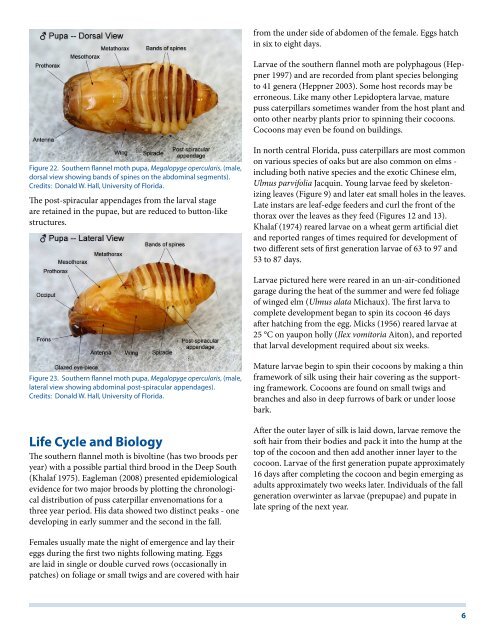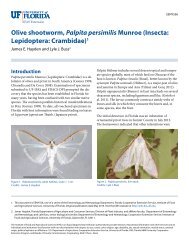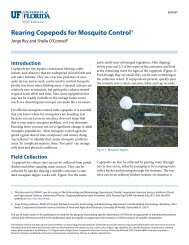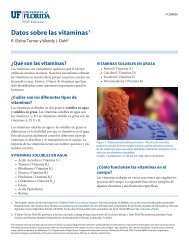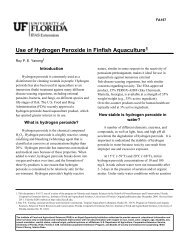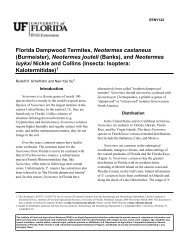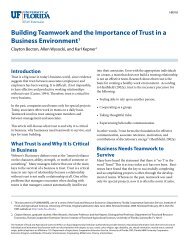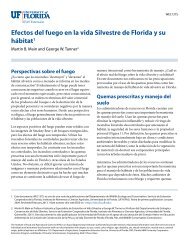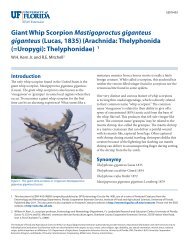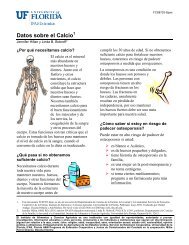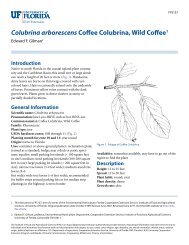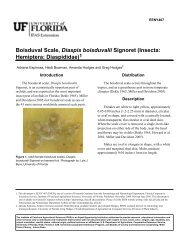Puss Caterpillar (Larva), Southern Flannel Moth (Adult ...
Puss Caterpillar (Larva), Southern Flannel Moth (Adult ...
Puss Caterpillar (Larva), Southern Flannel Moth (Adult ...
You also want an ePaper? Increase the reach of your titles
YUMPU automatically turns print PDFs into web optimized ePapers that Google loves.
Figure 22. <strong>Southern</strong> flannel moth pupa, Megalopyge opercularis, (male,<br />
dorsal view showing bands of spines on the abdominal segments).<br />
Credits: Donald W. Hall, University of Florida.<br />
The post-spiracular appendages from the larval stage<br />
are retained in the pupae, but are reduced to button-like<br />
structures.<br />
Figure 23. <strong>Southern</strong> flannel moth pupa, Megalopyge opercularis, (male,<br />
lateral view showing abdominal post-spiracular appendages).<br />
Credits: Donald W. Hall, University of Florida.<br />
Life Cycle and Biology<br />
The southern flannel moth is bivoltine (has two broods per<br />
year) with a possible partial third brood in the Deep South<br />
(Khalaf 1975). Eagleman (2008) presented epidemiological<br />
evidence for two major broods by plotting the chronological<br />
distribution of puss caterpillar envenomations for a<br />
three year period. His data showed two distinct peaks - one<br />
developing in early summer and the second in the fall.<br />
Females usually mate the night of emergence and lay their<br />
eggs during the first two nights following mating. Eggs<br />
are laid in single or double curved rows (occasionally in<br />
patches) on foliage or small twigs and are covered with hair<br />
from the under side of abdomen of the female. Eggs hatch<br />
in six to eight days.<br />
<strong>Larva</strong>e of the southern flannel moth are polyphagous (Heppner<br />
1997) and are recorded from plant species belonging<br />
to 41 genera (Heppner 2003). Some host records may be<br />
erroneous. Like many other Lepidoptera larvae, mature<br />
puss caterpillars sometimes wander from the host plant and<br />
onto other nearby plants prior to spinning their cocoons.<br />
Cocoons may even be found on buildings.<br />
In north central Florida, puss caterpillars are most common<br />
on various species of oaks but are also common on elms -<br />
including both native species and the exotic Chinese elm,<br />
Ulmus parvifolia Jacquin. Young larvae feed by skeletonizing<br />
leaves (Figure 9) and later eat small holes in the leaves.<br />
Late instars are leaf-edge feeders and curl the front of the<br />
thorax over the leaves as they feed (Figures 12 and 13).<br />
Khalaf (1974) reared larvae on a wheat germ artificial diet<br />
and reported ranges of times required for development of<br />
two different sets of first generation larvae of 63 to 97 and<br />
53 to 87 days.<br />
<strong>Larva</strong>e pictured here were reared in an un-air-conditioned<br />
garage during the heat of the summer and were fed foliage<br />
of winged elm (Ulmus alata Michaux). The first larva to<br />
complete development began to spin its cocoon 46 days<br />
after hatching from the egg. Micks (1956) reared larvae at<br />
25 °C on yaupon holly (Ilex vomitoria Aiton), and reported<br />
that larval development required about six weeks.<br />
Mature larvae begin to spin their cocoons by making a thin<br />
framework of silk using their hair covering as the supporting<br />
framework. Cocoons are found on small twigs and<br />
branches and also in deep furrows of bark or under loose<br />
bark.<br />
After the outer layer of silk is laid down, larvae remove the<br />
soft hair from their bodies and pack it into the hump at the<br />
top of the cocoon and then add another inner layer to the<br />
cocoon. <strong>Larva</strong>e of the first generation pupate approximately<br />
16 days after completing the cocoon and begin emerging as<br />
adults approximately two weeks later. Individuals of the fall<br />
generation overwinter as larvae (prepupae) and pupate in<br />
late spring of the next year.<br />
6


